This article focuses on small silver items that were popular in the 18th century, from strainers to tobacco boxes to jewelry, describing the uses for each, and it notes how often silver items were stolen or lost. It originally appeared as a two-part series in the March and April 1942 issues of American Collector magazine, a publication which ran from 1933-1948 and served antique collectors and dealers.
Part I:
“Stole at Flatbush on Long-Island, One Silver Tankerd, a piece of Money in the Led of King Charles II, and the Led all engraved, a Coat of Arms, before (in it Man on a Waggon with two Horses) mark’d on the Handle, L P A. One Silver Tankerd plain, with a Piece of Money in the Led, mark’d on the Handle A P or A L. One Cup with two twisted Ears chas’d with Skutchens, marked L P A. One Tumbler marked L P A. One Dutch Beker weighs about 28 Ounces, Engraved all around, marked L P A. All the above were made by Mr. Jacob Boele, Stamp’d IB. One large Cup with two cast Ears, with Heads upon them and a Coat of Arms, Engraved thereon. One Cup with two Ears, a small hole in the Bottom…Whoever can inform Peter Lefferts of Flatbush on Long-Island, or Abraham Lefferts in New-York, so that it may be had again, shall have Fifteen Pounds Reward and no Question asked.” — The New-York Gazette, October 1-8, 1733.

Illustration I: Early Spout Cup: By Jeremiah Dummer, Boston, 1645-1718, this piece with two handles, nicely curved, spout and lid with finial is characteristic of the simplicity of 17th-Century American silver.
These lines, similar to many other advertisements published during that period, give us a picture of the unsafety of the times. Silver, or plate as it was sometimes called, was a rare and desirable article, especially when the trade balance was adverse, as was mostly the case under the baneful influence of the English kings of the 18th Century. Their one-sided exploitation of the Colonies was a shortsighted policy comparable to that which caused the downfall of the Roman Empire.

Illustration II: A 17th-Century Dram Cup: Made by John Hull and Robert Sanderson, the Boston silversmiths who became partners in 1652 when the former was appointed mintmaster of the Massachusetts Colony. Hull learned silversmithing in Boston; Sanderson was London trained.
As for the problem of theft, although there were no newspapers in 17th-Century America, various diaries, such as that of Judge Samuel Sewall, indicate that there were plenty of offenders even in those stern days. In fact, the owner of silver was in a difficult situation. If through astuteness and forceful business sense he was able to accumulate a quantity of silver in the form of coins, he had no bank or safe deposit vault to turn to. The early land banks were all failures and the day of the gilt-edge security was far in the future. So he called in the silversmith and commissioned him to make tankards, salvers, and other household pieces. These satisfied his pride, embellished his home with beautiful things, and afforded a measure of security since he had a better chance to recover such pieces if they were stolen than silver coins that could easily be spent in taverns and other places.

Illustration III: Strainer Dated 1765: It was made by Jonathan Clarke, 1705-1770, who worked first in Newport and later in Providence. It has a perforated inscription reading, "Jabez Bowen, Providence, January 1765."
This advertisement in the Gazette is of more than passing local interest. Mr. Jacob Boele is of course the famous silversmith, Jacob Boelen, who arrived in New York in 1660. He was a distinguished burgher, assessor, and became alderman of the North Ward. His son, Henricus Boelen, continued the business after the death of Jacob in 1729 and was in turn succeeded by Jacob Boelen II. The name Lefferts is still in the memory of New Yorkers through the avenue by that name in Brooklyn. It is quite significant that the owner affirms no questions will be asked. His main interest was the safe return of his cherished pieces of silver rather than punishment of the thief.

Illustration IV: Large Wine Syphon: Although it has not been possible to ascertain the maker's identity, it is probably an example of 18th-Century American silversmithing.
Apparently the citizens of Philadelphia took a much sterner view of such offences if we are to judge by a news item from that city which appeared in the New York Gazette of April 27, 1752. It reads: “Friday last the trial of John Webster came on. When he was indicted and found guilty of breaking open the dwelling house of William Clemm of this city on the 24 of December 1750 in the night; and taking from thence a silver teapot and teaspoon; upon which he received the sentence of death.”
But cities were not the only unsafe places. Further inland and in rural areas the lure of silver pushed people from the straight and narrow path. As late as 1845 a silversmith in Vermont was informed one day that several miles away there was a man lately returned from a successful business trip to the West Indies with not only a substantial letter of credit but a nice balance of silver coins. So the Vermont craftsman, looking for raw material that was hard to get, saddled his horse and with two saddlebags in front of him rode through the hilly and wooded country.

Illustration V: A Rare American Marrow Scoop: Its maker was John Burt Lyng, a New York silversmith. As he was made a city freeman in 1761 and died in 1785, pieces bearing his touch-mark are mostly pre-Revolutionary.
But the silver rumor had spread, even to the lumbermen of the section, and when the silversmith came back through the woods after a successful trade transaction, there was a holdup. One of the lumbermen seized the reins and told him to get off the horse. But the rider was prepared. He drew an old flintlock pistol concealed behind one of the bags and with precise aim shot one finger from the hand that had seized the reins. No one ever molested him again. Somehow the rumor got about that here was a man who could and would shoot. He, for his part, never bothered to prosecute the erring lumberman. Besides it would have been hard to identify him since practically no lumberman had all ten fingers intact.

Illustration VI: 17th-Century Sucket Fork: With a two-tined fork at one end and a spoon bowl at the other, this piece bears the mark IK. The identity of this silversmith has not yet been established. He worked circa 1690-1700, probably in Albany
Although American silversmiths never indulged in mere copying of foreign pieces, the general style of their work follows the European pattern, changing from the simple and austere designs of the middle 17th Century to the brighter and more ornate ones of the William and Mary period; becoming more refined and reverting to simpler forms in the reign of Queen Anne; then swinging to the effervescence of the rococo which bridged the Atlantic and left its mark on different forms and decorations. Finally, with a changing Europe and the creation of our independence, there came the chaste style which bore the name of the Brothers Adam and was an adaptation of Roman classic dignity.

Illustration VII: A Syphon with Pump: Made by Frederick Marquand, New York, circa 1820. An ivory knob forms the outer end of the pump plunger. Frederick, Isaac and Jospeh P. Marquand were partners, first as Marquand & Bros.; then Marquand & Co. Other partners were admitted and gradually the firm name was changed. Today it is Black, Starrr & frost-Gorham, Inc.
Therefore, we now mention, without any attempt at completeness, certain implements that had to do with eating and drinking — such as heating dishes, sugar tongs, pepper-pots; articles made for style and vanity, like patch boxes, shoe buckles, spurs, and silver miniatures; also, jewelry, silver or silver gilt, very simple in form; and some rare pieces that seem to fall under the head of oddities.

Illustration VIII: Early 19th-Century Pap Cup: William Thomson worked in New York as a silversmith until 1834. His touch-marks were frequently "W. Thomson" in script letters, "New York" in Roman capital letters, and the year the piece was made in Arabic numerals.
SPOUT CUPS: These were primarily intended for use in case of illness. Shown here is an early two-handled one by Jeremiah Dummer, Boston, 1645-1718. Possibly the two handles in this example were made so that the patient could get a firm grip in sipping the hot contents or the bitter medicine given to him in the cup. But these little vessels, which measured from three to five and one-half inches in height, were also useful in the daily routine of domestic life and were made both with and without a cover (Illustration I).
DRAM CUPS: The word dram may have several meanings and is probably derived from the Greek, drachme. It may mean a small quantity. We also have an apothecary weight of that name equalling sixty grains or one-eighth part of an ounce. It may mean a small drink, such as could be swallowed in one gulp. This, together with the use of these dainty vessels for tasting wine or spirituous liquors, probably accounts for the name. In England they always figured as tasters. The one illustrated is very early and was made by John Hull and Robert Sanderson, Boston. This firm probably started about 1652 (Illustration II).

Illustration IX: A Small, Early Brazier: Made by Adrian Bancker, a New York silversmith from before 1731 until 1772. Son of an early mayor of Albany, he came to New York, served his apprenticeship under Henricus Boelen, and in 1731 was made a freeman of the city.
STRAINERS: These were used later for tea making but their earlier use was related to punch and kindred convivial drinks. The example shown here was made by Jonathan Clarke, Newport and Providence, Rhode Island, 1705-1770, and is quite remarkable. It has a perforated inscription, “Jabez Bowen, Providence, January 1765.” Bowen was First Chief Justice of the Superior Court, Rhode Island, then Deputy Governor and member of the State Convention that adopted the Constitution in 1790 (Illustration III).
SYPHONS: As their name indicates, these were for transferring wines and stronger beverages from barrels, jugs, or demijohns to ordinary bottles or decanters. Of the two shown, the most remarkable is the one with the hand pump. There are also small syphons that were practically used as spouts if no spout cup was at hand (Illustrations IV and VII).

Illustration X: Two Butter Testers: These were pushed into a tub of butter for a sample on which to grade it. The upper one bears the mark, TK, which was that of Thomas Kinney, Norwich, Connecticut, and the lower one by Thomas Hamersly, recorded to have been working as a silversmith in New York, circa 1756.
MARROW SCOOPS: Marrow, the paste inside the meat bone, was once considered a delicacy so the use of these little silver scoops is self-evident. However, marked American marrow scoops are quite rare. The one illustrated is by John Burt Lyng, New York, 1761-1785 (Illustration V).
SUCKET FORKS: Until the end of the 18th Century sucket was the every-day term for a sweetmeat in syrup. It comes from the French, succade, which in turn derives from the Spanish, succada, meaning sweet preserved fruit and possibly other sweet dishes. The end with the fork was used to pick up the sticky fruit and the spoon end served its legitimate purpose. The piece shown here has the mark IK, an unknown silversmith probably working 1690-1700 (Illustration VI).

Illustration XI: Sugar Tongs: Made by George Fielding, New York circa 1731, these open and shut like a pair of scissors, which was an unusual design for such pieces.
PAP CUPS: They were chiefly used for feeding small children the needed liquid food. They always had soft edges so that if the infant grasped the cup no harm would be done. The one shown is of remarkable elegance of form and has a very fine decoration. It was made by William Thomson, 1810, New York silversmith (Illustration VIII).
BRAZIERS: The one illustrated is an early example by Adrian Bancker, 1703-1772. It is small and simple in form with original wooden handle. The chafing dish is descended from these early dishes for keeping food warm. Charcoal was used for heat (Illustration IX).

Illustration XII: A Nutmeg Grater: By John Coburn, Boston, 1725-1803. With tight fitting cover and containing both grater and nutmeg, this was made to be carried in the owner's pocket.
BUTTER TESTERS: Butter testers are proof of the shrewdness of our American merchants who dealt in farm products. They had to dig into the butter firkin to make sure that the quality beneath the surface was the same all through (Illustration X).
SUGAR TONGS: Sugar tongs were usually of the pincer type, but a few were made in the design of a pair of scissors. To the latter belong those shown here. They were made by George Fielding, New York silversmith, 1731, are very handsome, sturdy and functional without openwork or delicate detail (Illustration XI).
NUTMEG GRATERS: Nutmeg also came from the East Indies. Being a hard nutlike seed, it had to be grated when used for seasoning. American and European silversmiths made graters in box, cylindrical and other shapes which opened for use and had space for the nutmeg. Owners carried them much as cigarette lighters are carried today. The example here is by John Coburn, Boston, 1725-1803 (Illustration XII).

Illustration XIII: An Early Pepper Pot: By Samuel Gray, 1684-1713, who worked in both Boston and New London. The design is similar to English ones of the same kind and period.
PEPPER POTS: Pepper, then as now, came from the East Indies. Until the 19th Century it was expensive. Hence, finely wrought pieces of table silver were made for this seasoning. The example shown here is very similar to contemporary English ones. It was made by Samuel Gray, Boston and New London, Connecticut, 1684-1713 (Illustration XIII).
TOBACCO BOXES: In Colonial America men of means prized tobacco containers of silver that would slip into a pocket. The box illustrated bears the touch-mark of John Coney and was made in 1701. Engraved with the Jeffries arms, it has a delicate rope edging and on the bottom are the words, “Donum R.G. 1701” (Illustration XIV).
PATCH BOXES: The patch box was a “must” in the days when the dear ladies added a special touch to their beauty with little round black patches. Probably this custom derived from France where it was in vogue during the reign of Louis XVI. The box shown bears the mark of Edward Webb of Boston who died in 1718 (Illustration XV).
DECORATIVE ACCESSORIES: A rare piece of silver is the book clasp by William Jones, Marblehead, Massachusetts, 1694-1730. It probably adorned a Bible given as a wedding present (Illustration XVI).
Part II:
Miniature silver, jewelry, dress accessories, and kindred pieces made by American silversmiths during the Colonial period and for a half century afterward are much rarer than larger pieces of the same period. This is not because they were unpopular. On the contrary, contemporary newspaper advertising contains many references to these smaller pieces, on hand or to be made for “Ladies and Gentlemen according to their Desires, Punctually and in the best Manner.”
Also, these same advertisements were records of how easily and often such small silver was lost or stolen. Picked at random from New York newspapers during the half century previous to 1776, one finds that on August 31, 1741, a thief visited Shepard Kollock and carried off twenty-odd pieces of jewelry and small silver including “One Child’s Spoon marked M G; a Silver Scissars Chain marked on a Heart M G; a Silver Watch Chain and Pincushion Chain.” On March 18, 1754, Isaac Seixas was also relieved of quite a parcel of silver, including a “Silver Pepper Box, and a Salt-Cellar…and a Pair of Boy’s Silver Buckles.”
Owners of silver pepper pots apparently had difficulty in keeping them. At least one appeared in most lists of stolen silver. Rather unusual was the taste of the burglar who broke into a house November 14, 1737, and took “a small Silver Square, a Level, a Plumb-Rule, and Silver Pen, and other Utensils belonging to the Lodge of Free Masons in New-York. Whoever brings them to the Printer hereof shall be handsomely rewarded and no Questions ask’d.” This offer was also appended to two advertisements entered in the year 1738, one regarding an oval snuffbox, “Lost or Stolen,” and a silver snuff mill, “Lost or Mislaid.”
Absentmindedness also accounted for the disappearance of small items as we read in the New York Mercury of March 3, 1766, when one of the solid citizens of the town, “Lost, or left on one of the Pews in the Presbyterian Meeting House, an oval Silver Snuff-box with a Mother-o’pearl Top, mark’d with the Letters T. G. C. Whoever has found it and will bring it to the Printer hereof, shall have Five Shillings Reward.” Another snuff box, “lost out of a gentlemen’s pocket some time ago,” was apparently treasured for sentimental reasons as the owner offered “Two Dollars reward, which is more than its value.”
There is, of course, no way of knowing whether these owners recovered their small but valued silver. It is safe to say, however, that loss or theft accounted for the disappearance of many such pieces. Normal wear was another factor. Bent or broken, the cost of repair might not seem warranted. Similarly, as the years passed these trifles were not as treasured as larger pieces. So, “sold down the river” as scrap they vanished into the melting pots.
As to silver jewelry, the rarest of course is that of the 17th Century. Later years saw America better established and prosperous enough for gold jewelry. Hence, comparatively few pieces of such silver were preserved as heirlooms. Costume accessories of the 18th Century also were displaced by newer fashions when the dress of both men and women underwent radical change after the turn of the 19th Century. Silver shoe, breeches, and stock buckles, coat buttons of engraved silver, most of them went into the melting pot.
These little pieces of miniature silver and jewelry are today scarce enough to add zest to the hunt for the collector. They also add their bit to the record of Early American manners and customs.
The sucket fork as an ingenious piece of table silver was mentioned last month. Good fortune brought another pair to our notice. They are more delicate in design than the one illustrated in the March issue of American Collector, having details of decoration that give them the aspect of small medieval weapons. Incidentally, we would like to correct an error regarding derivation of the name of these domestic implements. The source word for sucket is not Spanish but the Italian, zuccata.
The achievements of the patriot, Paul Revere, 1735-1818, has added significance today. The shoe buckle with silver frame and the spur shown here testify to the excellence of his craftsmanship whether working on large or small objects.
A common product of most silver shops was the doll-size teaspoon. These little spoons, two inches or less in length but identical in form and shape with those of standard size, were the work of apprentices and younger journeymen. Their making was freehand work without aid of dies for cutting the outline or forming the bowl. Thus, young workers gained training of eye and hand and the little spoons became tests of skill. In the 19th Century such spoons sold for twenty-five cents each and a small girl who had a set of six was considered fortunate indeed.
Philadelphia was the hometown of much silver jewelry. Although elaborate jewelry was imported, the pieces made there were simple and modest. Examples illustrated include a pair of cuff links bearing the mark of Joseph Richardson, the elder, 1711-1784; a chatelaine without chain by S. Richards, who died in 1796; and a chatelaine with chain by Joseph Shoemaker, made about 1795.
A real model of simplicity is the little silver clasp by the New York silversmith, Joel Sayre, 1778-1818, with engraved initials E B S. It was probably the clasp for a bracelet of velvet or braided hair. Also of New York vintage are the ingenious pair of spectacles with silver frame, made by Edmund Darrow, 1843-1861. The temples are adjustable and may be lengthened to fit the distance from eye to ear or shortened to fit into the case.
For the collector of silver miniatures, the very early little dram cup made by William Cowell, the elder, of Boston, 1682-1736, has both the charm of rarity and the beauty of fine though simple design. There is also real beauty in the sturdy little teapot made by Samuel Bartlett, 1750-1821, who worked in Concord and Boston.
Among the oddities produced by silver craftsmen, perhaps none is more unusual than the combination of a spoon and a nutmeg grater. The example illustrated, with both front and back view to show how the top of the handle served its special purpose, was made by Ebenezer Chittenden, 1726-1812, who worked in New Haven and Madison, Connecticut.
Such then, is our record of just a few marked pieces of Early American miniature silver. Space does not allow us to extend the list, but we know that the ingenuity of our old craftsmen and the demand of their public created many more interesting and often exquisite pieces. Some are now part of museum collections; others the pride of a few privileged collectors; still others may yet remain to be found.
This article originally appeared in American Collector magazine, a publication which ran from 1933-1948 and served antique collectors and dealers.
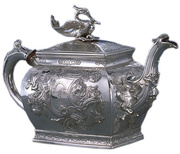
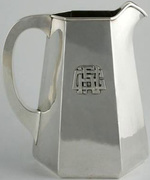 The Kalo Shop, a Mecca for Arts and Crafts Sterling Silver
The Kalo Shop, a Mecca for Arts and Crafts Sterling Silver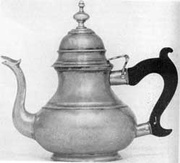
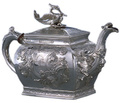 Janine Skerry Shows Off the Silver Collection at Colonial Williamsburg
Janine Skerry Shows Off the Silver Collection at Colonial Williamsburg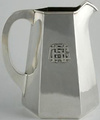 The Kalo Shop, a Mecca for Arts and Crafts Sterling Silver
The Kalo Shop, a Mecca for Arts and Crafts Sterling Silver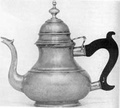 Silver in the World of Washington Irving
Silver in the World of Washington Irving Mari Tepper: Laying it on the Line
Mari Tepper: Laying it on the Line Nice Ice: Valerie Hammond on the Genteel Charm of Vintage Canadian Costume Jewelry
Nice Ice: Valerie Hammond on the Genteel Charm of Vintage Canadian Costume Jewelry How Jim Heimann Got Crazy for California Architecture
How Jim Heimann Got Crazy for California Architecture Modernist Man: Jock Peters May Be the Most Influential Architect You've Never Heard Of
Modernist Man: Jock Peters May Be the Most Influential Architect You've Never Heard Of Meet Cute: Were Kokeshi Dolls the Models for Hello Kitty, Pokemon, and Be@rbrick?
Meet Cute: Were Kokeshi Dolls the Models for Hello Kitty, Pokemon, and Be@rbrick? When the King of Comedy Posters Set His Surreal Sights on the World of Rock 'n' Roll
When the King of Comedy Posters Set His Surreal Sights on the World of Rock 'n' Roll How One Artist Makes New Art From Old Coloring Books and Found Photos
How One Artist Makes New Art From Old Coloring Books and Found Photos Say Cheese! How Bad Photography Has Changed Our Definition of Good Pictures
Say Cheese! How Bad Photography Has Changed Our Definition of Good Pictures Middle Earthenware: One Family's Quest to Reclaim Its Place in British Pottery History
Middle Earthenware: One Family's Quest to Reclaim Its Place in British Pottery History Fancy Fowl: How an Evil Sea Captain and a Beloved Queen Made the World Crave KFC
Fancy Fowl: How an Evil Sea Captain and a Beloved Queen Made the World Crave KFC
I have what I believe to be an 18th man’s sterling silver shoe buckle. It belonged to my mother. It is really more of a cover in that it is solid. It is rather ornate. How can I go about finding out what it might be wroth?
Just curious of the possible age of a tiny cup. On the bottom says Webster Sterling 22541
I have a very small spoon that has been in my family for many generations. The stamp is WI and it has a colonial look. I think it may be by William Jones of Connecticut and, later, Marblehead Massachusetts. In fact I have colonial Jones ancestors from Waterbury where I think he was born. I know he died young….but the spoon is lovelyh and I wish I knew more about Mr. Jones and his family history.
Am wondering about my very small silver (with markings on bottom) measure for 1/8 pint. The mark looks like “The BARBOUR SILVER CO. #4901
An engraving on the outside says: “McClintocks”
I have a set of 4 lovely demitasse spoons; with shell ornamentation on the end. They are stamped William H Frost and appear to be coin silver.
I’ve been unable to find any information on William H Frost, does anyone know this name and where this may have been made? Thanks so much!
Donarita, the WI spoon sounds like a coffee spoon, and should be 4-5″ long. If it really is by Jones, I would expect it to have a tapered tail on the bottom of the bowl (rat-tail). If you want to compare it to a tablespoon made by Jones, North Hill Antiques has photos on cyberattic.com.
Tom,
What a nice surprise to receive your note while visiting my son in Massachusetts! William Jones might have appreciated that I was on his stomping-ground.
Yes, the little spoon is 5 and 1/4 in length and has exactly the same stamp as the one on cyberattic.com. I was a little bewildered as to why the cyberattic spoon has the imprint on the front of the spoon. (I think so, anyhow.)
Thank you for your comments and happy new year!
Donarita
Hi, I have a silver bowl of 5-1/2 diameter with six engrave apples and two handles. the inscription in the bottom says: metropolitan museum reproduction, JACOB BOELEN new york late 17 century. Corham silver xxx (something) i could’nt read it.
3731-9
5647-6
just wanto know the value of this piece.
Thank you.
It is amazing how well this article has held up over time – thank you for re-introducing it. I found it most valuable in terms of material culture.
I would like to make reference to the sucket fork that is marked IK. The mark is that of Jesse Kip a New York silversmith working in New York during the last quarter of the seventeenth century. There are a few other examples that are smilar to that of your example. I too onced owned a Jesse Kip spoon which I identified as belonging to Jesse Kips grandson.
I hope this information is of some help.
George
I have a pair of silver shoe buckles from my neighbors estate that came with a note that reads ” Shoe buckles made by Samuel Beach of Vermont in 1763 or 1764. They were made from the silver ornaments worn by an Indian Chief whom Mr. Beah killed in a battle during the French and Indian war. Were passed down through the generations to the Samuels in the family. Were given to Florence Cooley Miller by the last Samuel Cooley. The father of Samuel Beach was Gersham Beach- great, great, geat grandfather of Marsden Miller and armorer for the state of Massachusetts”. I also have dozens of old documents, notes, wills and references of said buckles along with many photos of 6 of the 7 generations that owned them. They are beautiful and in wonderful condition. I wonder what thier value is?
My wife bought a little silver pouring jug with the initials TK stamped on the bottom, its a nice little piece but we know nothing about it.
could you tell me more about the pine tree shilling and others coins he made and if any were made out gold . I have four different ones. no Idea really need some help. thank you. Shawn Hanson.
I recently found out that I am related to John Burt Lyng and would like to see about where to purchase some sort of work from him. I would be greatful if anuone can help me to find something that he made , he was a silversmith in New York during the 1750’s to the 1780’s.
His works are in museums around the world.
Thank anyone who can give me any information.
Eileen M. Tillman